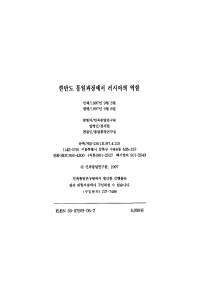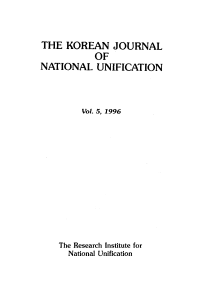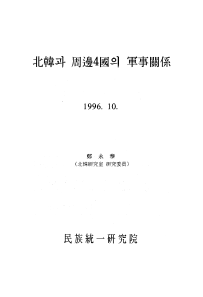
연구원발간물Study Series 2016-04
Development of Unification Diplomacy Contents: From the Perceptive Point of View
- 발행사항
- Seoul : Korea Institute for National Unification, 2016
- 형태사항
- 67p. ; 23cm
- 총서사항
- Study Series
- ISBN
- 9788984798434
- 청구기호
- 000 SS16-04
소장정보
| 위치 | 등록번호 | 청구기호 / 출력 | 상태 | 반납예정일 |
|---|---|---|---|---|
이용 가능 (2) | ||||
| 1자료실 | G0016116 | 대출가능 | - | |
| 1자료실 | G0016117 | 대출가능 | - | |
이용 가능 (2)
- 등록번호
- G0016116
- 상태/반납예정일
- 대출가능
- -
- 위치/청구기호(출력)
- 1자료실
- 등록번호
- G0016117
- 상태/반납예정일
- 대출가능
- -
- 위치/청구기호(출력)
- 1자료실
책 소개
Unification diplomacy refers to broadening international consensus on inducing changes in North Korea and establishing unification of the Korean Peninsula along with reinforcing cooperation among international communities. There is an urgent need to develop contents for unification diplomacy that aims to convince the political sphere, government, and citizens of the states surrounding the Korean Peninsula, including four super powers, the United States, Japan, China and Russia, to hold a positive outlook on Korean unification. Especially, the shift in Northeast Asian order and strategic environment requires adjustment in unification diplomacy direction customized to each country surrounding the Korean Peninsula.
This paper aims at developing specific logic for each country surrounding the Korean Peninsula to gain support for South Korea-led unification, publishing basic resources to assure solid support for South Korea-led unification by allaying concerns of unification costs, and developing dissemination strategy that could effectively deliver contents of unification diplomacy in each country.
With the aforementioned purpose, the paper takes the following structure. Chapter II “Logic and Strategy of Unification Diplomacy toward the U.S.” predicts the possibility of U.S. entrapment in a conflict between its allies/partners and China, and prospects the situation of U.S. alliance/security dilemma. For a convincing unification diplomacy toward the U.S., the paper (1) suggests the incentive beyond the logic to support Korean unification, (2) navigates various channels and level of discussion for the ROK-U.S. bilateral cooperation and dialogue on East Asian regional order, (3) prepares strategy of linking and delinking several issues emerging from the North Korean issue, ROK-Japan relations, and ROK-China relations, (4) calls for the efforts to concentrate on sharing the vision of Korean unification ―established by dialogues within the domestic society―with neighboring countries.
Chapter III, “Logic and Strategy of Unification Diplomacy toward China,” lays out the measures to induce China’s support to achieve South Korea-led unification. Also, the author presents the unification costs and benefits that may be imposed on China in detail and suggests a development of logic tailored for China to newly recognize the contribution that Korean unification will bring.
Chapter IV, “Logic and Strategy of Unification Diplomacy toward Japan,” looks into South Korea’s logic and strategy of unification diplomacy toward Japan and proposes the direction of focus for South Korea’s unification diplomacy toward Japan.
Chapter V, “Logic and Strategy of Unification Diplomacy toward Russia” introduces the direction of logic and strategy that South Korea ought to take in its unification diplomacy toward Russia. To this end, the author examines Russia’s stance on Korean Peninsula and unification through Russian opinion groups, government agencies, and President Putin’s views and probes into South Korea’s direction of unification diplomacy toward Russia in three different contexts, Russia’s North Korea initiative and ROK-DPRK-Russia trilateral cooperation initiative; pending issues such as mass migration of North Korean defectors; and diplomacy and security logic.
Chapter VI, “Case Analysis of Diplomatic Failure toward Great Powers of Countries Newly Admitted in the International Community,” analyzes post-Soviet countries’ diplomatic orientation, and substantiates that the cases of newly independent states’ diplomatic failure toward great powers came as a result of their diplomatic orientation, focusing on Ukraine and Georgia.
목차
1. Introduction
2. Logic and Strategy of Unification Diplomacy toward the U.S.
3. Logic and Strategy of Unification Diplomacy toward China
4. Logic and Strategy of Unification Diplomacy toward Japan
5. Logic and Strategy of Unification Diplomacy toward Russia
6. Case Analysis of Diplomatic Failure toward Great Powers of Countries Newly Admitted in the International Community
7. Conclusion





